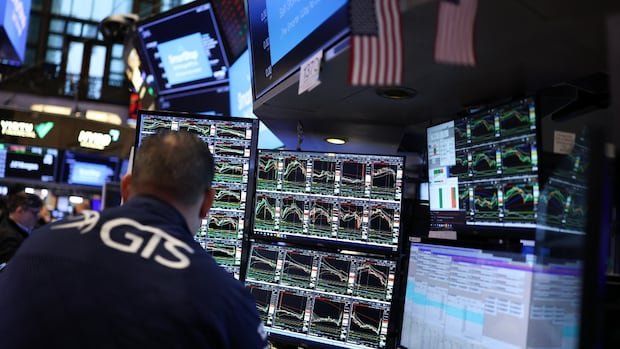U.S. stocks whipped through another dizzying day on Wednesday in the final hours before U.S. President Donald Trump unveiled the tariffs promised as part of his “Liberation Day,” which could drastically alter the global economy.
The S&P 500 rose 0.7 per cent, but only after careening between an earlier loss of 1.1 per cent and a later gain of 1.1 per cent. It’s had a pattern this week of opening with sharp drops, only to finish the day higher.
The Dow Jones industrial average added 235 points, or 0.6 per cent, and the Nasdaq Composite climbed 0.9 per cent. Both also veered from sharply lower in the morning to sharply higher in the afternoon before doubling back.
Canada’s main stock index, the S&P/TSX Composite, saw some dips throughout the day but predominantly moved up, adding 273.90 points, or 1.09 per cent.
Elon Musk’s Tesla helped knock the market around after initially falling more than six per cent following a report that it delivered fewer electric vehicles in the first three months of the year than it did in last year’s first quarter.
Tesla is one of Wall Street’s most influential stocks because of its immense size, and it’s faced backlash due to anger over Musk’s leading the U.S. government’s efforts to cut spending. But its stock erased its loss from the morning and ended with a gain of 5.3 per cent following a report from Politico that Trump has told others that Musk will step back from his government role in coming weeks.
Trump announces sweeping global tariffs
Financial markets around the world have been shaky lately because of uncertainty about what Trump would announce on Wednesday — but the timing of his announcement, after the closing of most markets, means stocks won’t show the full impact until Thursday.
After the market closed, Trump declared a 10 per cent baseline tax on imports from all countries and higher tariff rates on dozens of nations that run trade surpluses with the United States.
The president held up a chart while speaking at the White House, showing that the U.S. would charge a 34 per cent tax on imports from China, a 20 per cent tax on imports from the European Union, 25 per cent on South Korea, 24 per cent on Japan and 32 per cent on Taiwan.
The U.S. president said he will impose a 10 per cent baseline tariff on all imports to the United States that aren’t compliant with the Canada-United States-Mexico Agreement (CUSMA). While Canada and Mexico are spared from those ‘reciprocal’ tariffs, other levies that were previously announced are still on the table.
No additional across-the-board tariffs were placed on Canada on Wednesday, although Trump confirmed the U.S. was going forward with a 25 per cent tariff on all foreign-made automobiles, which could have a huge impact on Canada’s auto industry.
Previously announced tariffs on Canada, which were placed on pause until April 2, will be going forward, the White House said in a fact sheet. These include a 25 per cent tariff on Canadian goods (and 10 per cent on energy) originally announced in February, which made exceptions for importers who can prove the products they’re bringing in from Canada are compliant with the Canada-United States-Mexico Agreement (CUSMA).
Among the companies whose shares fell in after-hours trading were Deckers Outdoor Corporation, the maker of UGGs, which was down 9.3 per cent; Lululemon, down 8.8 per cent; and home products retailer Williams-Sonoma, down 8.4 per cent.
Prior to Wednesday, Trump had already announced levies against China, Canada and Mexico, and he expanded tariffs on steel and aluminum. He has also applied tariffs against countries that import oil from Venezuela and plans separate import taxes on pharmaceutical drugs, lumber, copper and computer chips.
Trump referred to Wednesday as an “important day,” calling it the country’s “declaration of economic independence.” He has claimed previously that tariffs would bring manufacturing jobs back to the U.S. and make global trade fairer. But tariffs could also grind down growth for the U.S. and other economies, as well as upend supply chains and throw regular global trading rhythms into disarray.
Surveys have shown deepening pessimism, but economists are waiting to see if that translates into actual damage for the economy.

On Wall Street, Newsmax, a conservative cable news outlet, fell 77.5 per cent in its third day of trading to give back some of the meteoric gains from its debut at the start of the week. It surged 735 per cent Monday and then another 179 per cent on Tuesday.
Several airlines, meanwhile, flew higher to recover some of the sharp losses taken recently on worries that tariff-weary customers will fly less. United Airlines climbed 4.6 per cent.
All told, the S&P 500 rose 37.90 points to 5,670.97. The Dow Jones industrial average added 235.36 to 42,225.32 and the Nasdaq Composite climbed 151.16 to 17,601.05.
In stock markets abroad, indexes were mixed across Europe after finishing mixed in Asia.


Leave a Reply